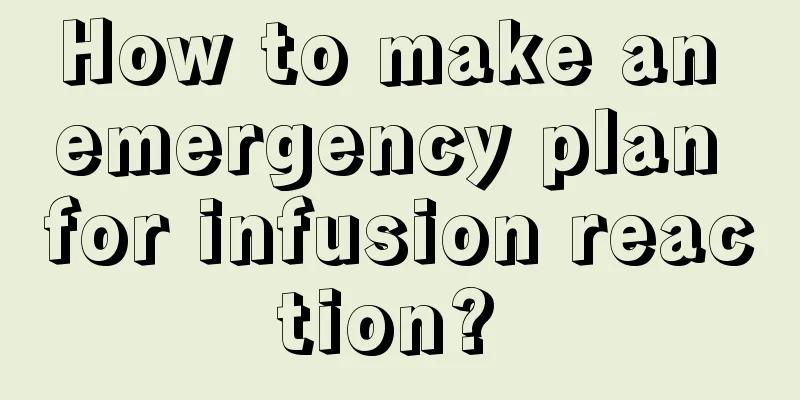How to make an emergency plan for infusion reaction?

|
Infusion is the most commonly used injection treatment method in life. It can allow the drug to slowly enter the body, but will reach the lesion site in the most thorough way to carry out anti-inflammatory treatment. Infusion is a very commonly used method, but infusion reactions caused by incorrect infusion methods or due to the patient's physical condition cannot be ignored. Medical workers are required to have emergency response capabilities to deal with infusion reactions. Let's take a look at how to make an infusion reaction emergency plan. 1. If an infusion reaction occurs, the infusion should be stopped immediately, the intravenous access should be maintained, and the patient should be temporarily replaced with normal saline. Vital signs should be observed immediately: blood pressure, pulse, respiration, etc. Physical cooling should be performed for those with high fever, and anti-allergic drugs should be given as prescribed by the doctor. The remaining solution and infusion bottle should be retained for bacterial culture. 2. In case of acute pulmonary edema, the infusion should be stopped immediately, and the patient should sit upright with legs hanging down. High-flow oxygen (6-8L, min) and alcohol (50%-70%) should be given. Sedatives and cardiotonic drugs should be given as prescribed by the doctor. If necessary, the limbs should be ligated alternately and appropriate pressure should be applied with a tourniquet or blood pressure gauge bag to block venous blood flow, thereby reducing the amount of blood returning to the heart and relieving the symptoms of pulmonary edema. For phlebitis, the affected limb should be elevated, and local hot compresses or physical therapy should be applied. If there is concurrent infection, antibiotics should be used according to the doctor's instructions. 3. When air embolism occurs, the patient should be immediately placed in the left lateral position with the head low and the feet high, so that the gas entering the right ventricle floats to its tip to avoid blocking the pulmonary artery outlet. The air is mixed into foam by the beating of the heart and enters the pulmonary artery in small amounts in batches. At the same time, oxygen should be given. In severe cases, the air can be extracted through the central venous catheter. 4. Blood pressure drops and symptoms of shock appear, which require emergency treatment: Epinephrine is the first choice for rescue. It has the effects of stimulating the heart, raising blood pressure, and relieving bronchospasm. Immediately inject 1mg/1ml subcutaneously or intramuscularly, let the patient lie flat, lower his head, drink boiled water, breathe oxygen, etc., and the reaction will be relieved in a short time for mild patients; for severe patients with shock symptoms, anti-shock rescue should be carried out quickly, and measures such as infusion, acid correction and vasoactive drugs should be taken. Epinephrine can be injected repeatedly every 15 minutes, or 0.1-0.5ml of epinephrine can be diluted with 10ml of normal saline and slowly injected intravenously, and 100-300mg of hydrocortisone can be added, diluted with 500ml of 5% glucose solution and dripped intravenously. |
<<: What should I do if eczema breaks out and yellow fluid oozes out?
>>: Why does Vajra Bodhi turn red after soaking in salt water?
Recommend
Side effects of intestinal hydrotherapy
Colon hydrotherapy is actually hydrotherapy of th...
What is the difference between smoothing and straightening
Softening and straightening are two completely di...
Can a benign lung tumor be cured?
Benign lung tumors are relatively rare, but there...
Is swelling of hands a kidney problem?
The kidney is one of the important organs in our ...
Egg white turns green
If you find that the egg whites you beat turn gre...
What are the principles of wound management?
In daily life, we are bound to encounter some sma...
Is Chinese medicine useful for treating laryngeal cancer?
There are many ways to treat laryngeal cancer, in...
What are the symptoms of endometrial cancer during pregnancy
As the number of patients with uterine cancer gra...
What's wrong with the choking in the chest?
Some people often feel choking in the chest when ...
Advanced prostate cancer survival period
In 2012, the incidence of prostate cancer in my c...
Progress in the treatment of non-small cell lung cancer
Lung cancer is a common health enemy of mankind. ...
What methods can be used to treat advanced lung cancer?
What are the treatment methods for advanced lung ...
How to treat cardiac bleeding
Cardiac inflammation is a chronic disease. Its sy...
Preparation of blood smear
Blood smear is a very important method for examin...
Where are human kidneys located
The kidney is a relatively important organ in the...









